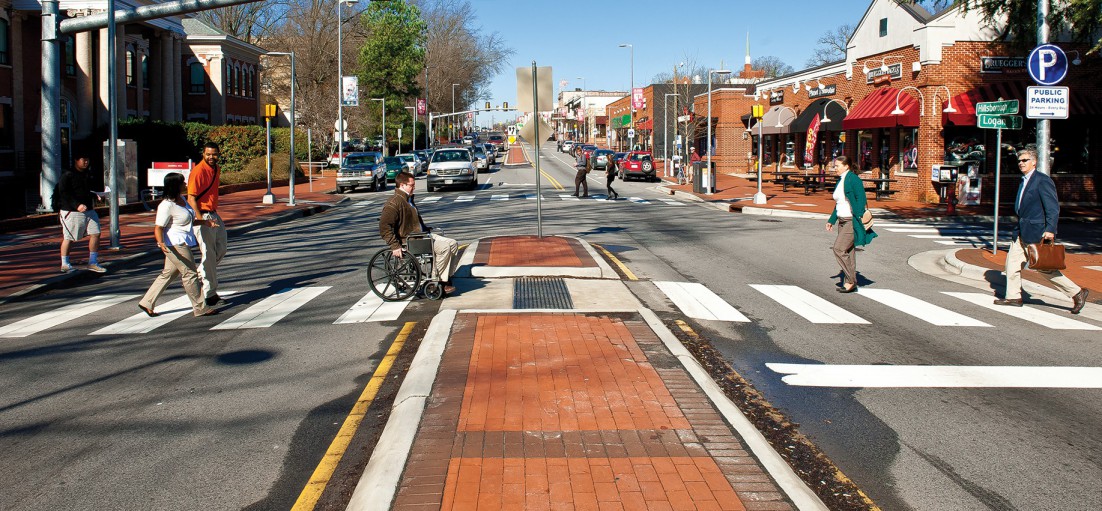Existing Conditions
Each year, between 150-165 pedestrians and 16-20 bicyclists are killed in collisions with motor vehicles on North Carolina roads, with many more seriously injured or experiencing evident or possible injuries. The high rates of pedestrian and bicycle crashes contribute to North Carolina's ranking as one of the least safe states for walking and bicycling.
During the five-year period from 2007 to 2011, a total of 4,700 bicycle-motor vehicle crashes and 12,286 pedestrian motor vehicle crashes were reported to North Carolina authorities (1). Crashes involving bicyclists and pedestrians are under-reported, so the number of individuals involved in and possibly injured in bicycle or pedestrian collisions is likely even higher than what is shown on record. These numbers show the prevalence and severity of pedestrian and bicycle crashes in North Carolina and highlight a major public safety issue in our state.
View the interactive 2007-2012 bicycle and pedestrian crash map
1. NCDOT Division of Bicycle and Pedestrian Transportation. (2013). 2007-2011 Bicycle and Pedestrian Crash Data.Speed Kills
The National Highway Traffic Safety Administration (NHTSA) has determined that excessive speeding is a factor in nearly one-third of all traffic fatalities and that the most dangerous roads are those with posted speed limits of 60 mph or higher. Speeding in residential areas is also a major cause of bicycle and pedestrian fatalities – chances of survival if hit by a vehicle traveling at 20 mph are 95 percent, yet drop to 50 percent at 30 mph and just 15 percent at 40 mph.
Pedestrian Chance of Survival
 Adapted from "Killing Speed and Saving Lives", UK Dept. of Transportation, London, England
Adapted from "Killing Speed and Saving Lives", UK Dept. of Transportation, London, England
The 2007 to 2011 data also revealed important trends related to minorities and safety. For example, Black/African-Americans were found to be over-represented as pedestrians and bicyclists involved in crashes. Black/ African-Americans make up 22% of the North Carolina population, yet 38% of pedestrians and bicyclists involved in crashes from 2007-2011 were reported to be Black/African-American. These results suggest that African-Americans may be disproportionately exposed to crash risks due to greater walking and bicycling rates, characteristics of the built environment that affect safety, or other factors.
From 2006-2010, 13% of all traffic fatalities in North Carolina were bicyclists and pedestrians.Traffic Safety Facts North Carolina 2006-2010. USDOT, National Highway Traffic Safety Administration
North Carolina Bicycle Crash Facts 2008-2012
Twelve Counties with highest numbers of bicycle-motor vehicle crashes
| County | % of NC total | 5 yr Crash Count | Average 1 yr Count | Average yearly crash rate per 10,000 residents | Prior Average yearly crash rate per 10,000 residents (2006-2010) |
|---|---|---|---|---|---|
| Wake | 13.3 | 651 | 130.2 | 1.4 | 1.4 |
| Mecklenburg | 11.9 | 580 | 116 | 1.3 | 1.4 |
| Guilford | 7 | 344 | 68.8 | 1.4 | 1.3 |
| New Hanover | 6.7 | 329 | 65.8 | 3.2 | 2.8 |
| Durham | 4.4 | 215 | 43 | 1.6 | 1.5 |
| Cumberland | 3.8 | 184 | 36.8 | 1.1 | 1.3 |
| Orange | 2.6 | 128 | 25.6 | 1.9 | 1.8 |
| Buncombe | 2.6 | 126 | 25.2 | 1.1 | 1.1 |
| Forsyth | 2.2 | 106 | 21.2 | 0.6 | 0.6 |
| Gaston | 1.9 | 93 | 18.6 | 0.9 | 1 |
| Robeson | 1.9 | 92 | 18.4 | 1.4 | 1.7 |
| Pitt | 1.9 | 91 | 18.2 | 1.1 | 1.1 |
| Total | 60.1 | 2,939 | 587.8 | 1.3 | 1.4 |
North Carolina Pedestrian Crash Facts 2008-2012
Ten NC cities with highest numbers of pedestrian crashes
| Municipality | % of NC total | 5 yr Crash Count | Average 1 yr Count | Average yearly crash rate per 10,000 residents | Prior Average yearly crash rate per 10,000 residents (2006-2010) |
|---|---|---|---|---|---|
| Charlotte | 14.2 | 1,869 | 373.8 | 5.1 | 5.1 |
| Raleigh | 7.4 | 975 | 195 | 4.8 | 5 |
| Greensboro | 5.7 | 751 | 150.2 | 5.6 | 4.6 |
| Durham | 4.3 | 569 | 113.8 | 5 | 4.4 |
| Fayetteville | 3.6 | 480 | 96 | 4.6 | 5.6 |
| Asheville | 2.6 | 340 | 68 | 8.1 | 7.2 |
| Wilmington | 2.2 | 290 | 58 | 5.4 | 5.4 |
| Winston-Salem | 2.1 | 276 | 55.2 | 2.4 | 2 |
| High Point | 1.6 | 216 | 43.2 | 4.1 | 4.1 |
| Gaston | 1.6 | 207 | 41.4 | 5.8 | 5.7 |
| Total | 45.3 | 1,194.6 | 5,973 | 4.9 | 4.7 |
North Carolina 2011 Bicycle and Pedestrian Safety Survey
The 2011 Bicycle and Pedestrian Safety Survey was administered by the Institute for Transportation Research and Education (ITRE) to gather information on North Carolinians' concerns, attitudes, and ideas for improvement regarding walking and bicycling safety. More than 16,000 responses were collected. The survey found that 80% of respondents feel that bicycling for daily needs is currently somewhat or very dangerous, while 43% said that walking for daily needs is currently somewhat or very dangerous.
- Top five bicycle and pedestrian safety issues cited:
- Lack of on-roadway bicycle facilities (82%)
- Lack of pedestrian paths and sidewalks (63%)
- Lack of alternatives to cycling on main arterials (55%)
- Lack of bicycle paths and greenways (53%)
- Motorists or bicyclists not sharing the road (50%)
According to survey respondents, the facility improvements that are most needed to improve safety for pedestrians and bicyclists are bike lanes on collectors and arterials (84%), sidewalks on collector streets and in commercial corridors (64%), paths and greenways (63%), and sidewalks on local and neighborhood streets (63%).





